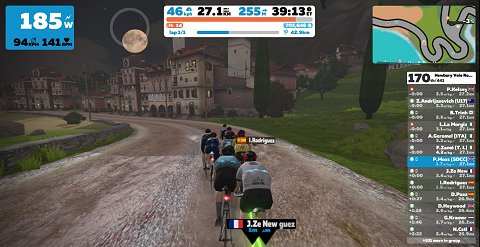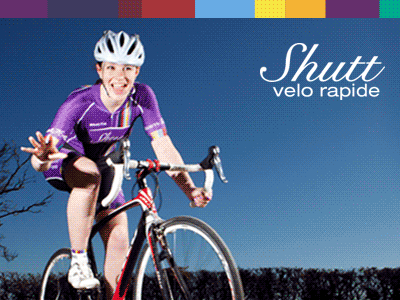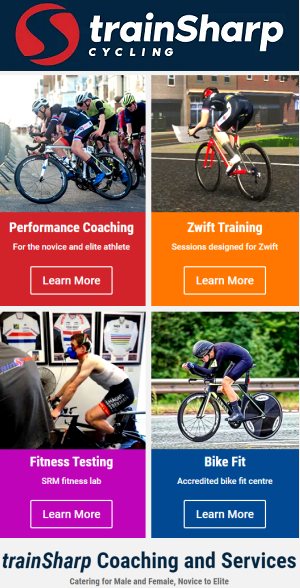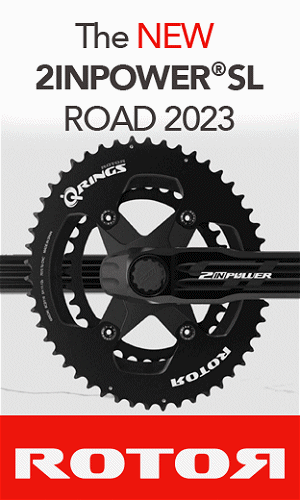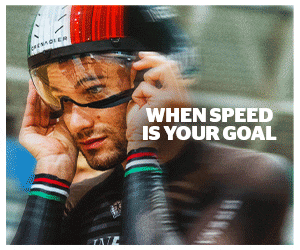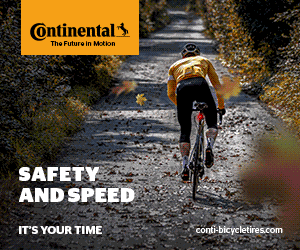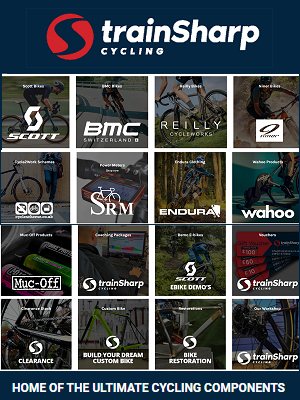A detail packed Q&A from Paul Moss, Chairman of Stowmarket & District CC and running an Ipswich and District Cycle Association Zwift TT league
E-Racing Q&A: Paul Moss
A detail packed Q&A from Paul Moss, Chairman of Stowmarket & District CC and running an Ipswich and District Cycle Association Zwift TT league who is based in Ipswich. Paul has raced mostly TT’s and cyclocross since 2006 and only really done Zwift racing the last month or two but says he has trained using ‘Sufferfest’ for a good five or six years.
Paul is currently running an Ipswich and District Cycle Association Zwift Time Trial league to replace the evening time trials. He uses two Zwift events per week and take times from those to produce a league. The SCRS/Norfolk Lotus League are going to do the same thing with a Zwift crit race.
Q: What are the essentials to have if you want to go Zwifting?
Paul: Any turbo trainer and bike or dedicated bike such as a Wattbike. The crucial thing is that it has to have some way of measuring power. This can be via the Zwift app itself if you have a speed sensor on the bike or from the trainer itself or from any power measuring device on the bike. If you do it from the app, it calculates “virtual” power by knowing what the power curve of the trainer is and calculating the power by using the speed your rear wheel is turning so the app needs to support the type of trainer you are using.
If the trainer itself measures power it will transmit that to the app via ANT+ or Bluetooth and similarly if you have a power measuring device i.e power cranks or pedals, it will transit the power numbers to the app via ANT+ or Bluetooth. The Zwift app itself can run on Android, iOS or Windows so you can use any of those devices as long as they can pick up ANT+ or Bluetooth. By far the most immersive way to use Zwift and any of the other platforms (Rouvy, BKool, RGT, Tacx, Sufferfest, Trainerroad) is to use a smart trainer.
A smart trainer not only measures power it is also controlled by the app itself so if you go up hill in the app, it will simulate that on the trainer by increasing the resistance to match and decreasing when you go downhill. A heart rate monitor is not really required but some results services i.e. Zwiftpower, require you to have a HR monitor in order for you to appear in the results. I would always advise using one anyway as it’s a good way of measuring effort and fatigue.
Personally, I use a pretty standard Windows laptop with an ANT+ dongle paired with a Wahoo KicKR core smart trainer and an Android phone for the Zwift companion app (the companion app is not essential but it is very useful for interacting with the game). Requirements for the other platforms are mostly the same although RGT won’t work if you don’t have the companion app and one of the others only supports smart trainers (can’t remember which).
Q: Why do you have to know how much you weigh and is that with all your clothing?
Paul: Because the e-racing is based around your w/kg. It calculates your speed in the race by what your w/kg are so your weight must be accurate. It pays to be as light as possible so I would always use a naked morning weight but that’s what anyone would normally do anyway wouldn’t they? I’m also a bit of an obsessive so my scales are linked to my Zwift profile so my weight is always up to date in Zwift good or bad.
Q: What is the best way to keep cool with e-racing?
Paul: A big fan! or two. Open a window if indoors or the shed door in my case and put the fan outside the door so it gets as much cool air in as possible. It’s OK to not wear many clothes! (Not on the bottom half though, that would be a) not nice and b) cause a lot of chafing!)
Q: What is a typical distance/length of race online?
Paul: Anything from 8km to about 75km. We race regularly race the Bologna 8km TT course from the 2019 Giro D’Italia. A lot of the crits range between 20 minutes and an hour and there are longer 70km races in the hills so a huge variety. I’ve certainly raced for over 2 hours.
Q: What is an ideal warmup for an e-race?
Paul: As you would outdoors to be honest. I use the standard BC 20 minute warm up
Q: Can you slipstream in a peloton in an e-race?
Paul: Yes and it’s a key skill to have in an e-race although not as effective as it would be outdoors.
Q: How hard is the effort in an e-race – ie, on the limit the whole time or can you back off and if so, how much?
Paul: On the limit pretty much the whole time. Almost all races start like a cross race, flat out for 5 minutes and then settle down a little. The longer ones have a bit more of a whittling down effect but essentially it’s about saving energy. There are tactics involved and concentration on what’s going on so you can get immersed in a race just like a real one.
… continued after advert
Q: Is e-racing like an egame and does it have different levels or categories?
Paul: Yes, generally speaking it’s a game. Yes, there are usually categories in the races based on the w/kg (there’s that metric again) you can sustain for the duration of that race. Some have age categories and some are women specific.
The good thing is though that women can often compete directly with the men as it’s just based on w/kg and some women can put out some impressive numbers! Zwift also has “gaming” features such as power ups, levels, drop points and “fantasy” bikes that you can unlock the further you go or the more challenges you complete.
The other platforms don’t have these and are geared to being more “realistic”. Lots of people get a bit stressy about being the right category and it’s easy to “cheat” if you put the wrong weight in which is where a results service like ZwiftPower comes in and attempts to filter out the obvious anomalies. A HR is often required so that a high wattage can be correlated to a high HR etc…
Remember though, it’s a computer game and there are lots of variations in setups, environments, power measurement etc… so DO NOT take it too seriously!
Q: What is about e-racing that is hard for pros even to get up to speed on straight away – what are the skills?
Paul: Some pros don’t have great numbers I guess but are extremely good at race tactics and saving energy which is not so easy in an e-race. Races start very fast, there is no neutral section! Some pros are living at altitude, some will be early morning or late at night depending on location. Lots of variations in setups.
Q: Are the normal mass group rides on there like races (like sportives) or is it more steady..
Paul: I’ve not really tried any but no, not really. If it’s not a race, there’s no timing so there’s no “winner”.
Q: Can riders find training sessions on there to help them get started with e-training
Paul: Yes. Zwift has lots of workouts built in as do most of the other platforms. Sufferfest even has specific training plans for e-racing which is odd when you think about it, training plans gearing you up to race on a competitors platform. Worth mentioning that Sufferfest and Trainerroad are training platforms and do not provide races and are much more geared to serious training plans leading to specific goals whereas Zwift et al are more “outdoor” riding replacements.
Q: Finally, do you find e-racing as much fun in a different way to normal racing?
Paul: Fun in a different way, yes but not as much fun as normal racing.
Cycle Division’s Shop
Send your results as well as club, team & event news here
Other Results on VeloUK (including reports containing results)
- RR Result: East Cleveland Classic
- Features, Reports, Results
- Q&A: Charlie Abraham (Lee Valley Youth Junior Cycling Team)
- Events: SSSCCRRL Road Race League
- Youth Result: Isle of Man Youth League
- Youth Result: Lawford Youth Series (Curborough) #2
- Crit Result: Full Gas Summer Circuit Series #2
- Crit Result: Ride Flux Spring Crit series #2
- Youth Result: Maindy Flyers Freewheel League 1
- Ribble Collective: Ride More in ’24
- Crit Result: Tameside Cycling Development Circuit Races 1
- Crit Result: 2024 West Thames League 1
- Startlist: The Drummond Trophy
- TT Result: VTTA Surrey/Sussex 10 mile TT
- EVENTS: Proper Northern Road Races – Round 2 Oakenclough
- TTT Result: Scorton TTT
- TT Result: Manchester & District TTA 25m TT
- TT Result: Stowmarket & District CC 15m TT
- TT Result: Paceline RT Sporting TT
- TT Result: Hereford & District Wheelers 25m TT
- RR Result: Yorkshire RRL #1
- Crit Result: Scottish Student Cycling Criterium Championships
- Events: Dave Peck Memorial
- TT Result: Blaydon CC Two Up TT
- TT Result: Kent CA 10m TT
- TT Result: Wessex RC 24m TT
- TT Result: Easterley RC 25m TT
- TT Result: Cranbrook CC 10m TT
- TT Result: Penzance Wheelers 12.5m TT
- TT Result: Fife Century RC 25m TT
- TT Result: Bramley Wheelers 10m TT
- TT Result: Mid Shropshire Wheelers 25m TT
- Youth Result: Hog Hill GP (National Youth Series)
- RR Result: Velo Club Venta Spring Road Race
- News: Women’s Tour of Britain
- Crit Result: Ennerdale Season Openers 2
- RR Result: NCRA Handicap RR (week 5)
- RR Result: Surrey League 2/3 (April 14)
- Report/Result: TLI Cycling Dave Astles Memorial Races
- RR Result: Cadence Junior Road Race
- Crit Result: Matlock CC Darley Moor Circuit Race #1
Other News on VeloUK
- Events: SSSCCRRL Road Race League
- Ribble Collective: Ride More in ’24
- Startlist: The Drummond Trophy
- EVENTS: Proper Northern Road Races – Round 2 Oakenclough
- Events: Dave Peck Memorial
- News: Women’s Tour of Britain
- Startlist: PB Performance Espoirs Road Race
- East Cleveland Classic: Saint Piran Team
- News: New kit for Ribble Rebellion Riders
- Events: Halesowen Friday Track Nights
- Team News: Ribble Rebellion off to the USA
- News: Pedal Club Lunch (March)
- Rider News: Winning start for Billy Ladle
- News: CiCLE Classic 2024
- Startlist: Stars of the SW Men’s U23 RR
- Startlist: Danum Trophy 2024 (Nat B)
- Startlists: London Dynamo Road Races
- Startlist: La Fleche Waltonne Road Races (BMCR)
- Meet Ribble HoloRider
- Startlists: East Cleveland Classic 2024
- Former Winners: Lincoln Grand Prix
- Chris Lawless Joins Saint Piran Team
- Paracycling Track Worlds Day 4
- Para CyclingWorlds Final Day
- Startlist: National Youth Circuit Series Rd 1
- Report/Result: Azets Spring Classic
- Startlists: RCR Fat Creations Road Races
- Startlist: Capernwray Road Race (March 31)
- Team Report: Fensham Howes MAS Design Junior Team
- Team Report: CiCLE Classic Junior Men
- RIDER REPORTS – Zoe Parker (Solihull CC)
- GB News: Two World Titles for GB at Para Worlds
- Team News: Alba Development Road Team
- News: British Road Champs Return to NE
- THIS WEEKEND: Peaks Two Day is Back!
- News: Laura Kenny Retires
- Team News: Lee Valley Youth Cycling Team
- 2024/25 CYCLO-CROSS CALENDAR
- Startlist: Cardiff Ajax CC 10 Mile TT
- Startlists: 16th Gifford Road Races (Scotland)






